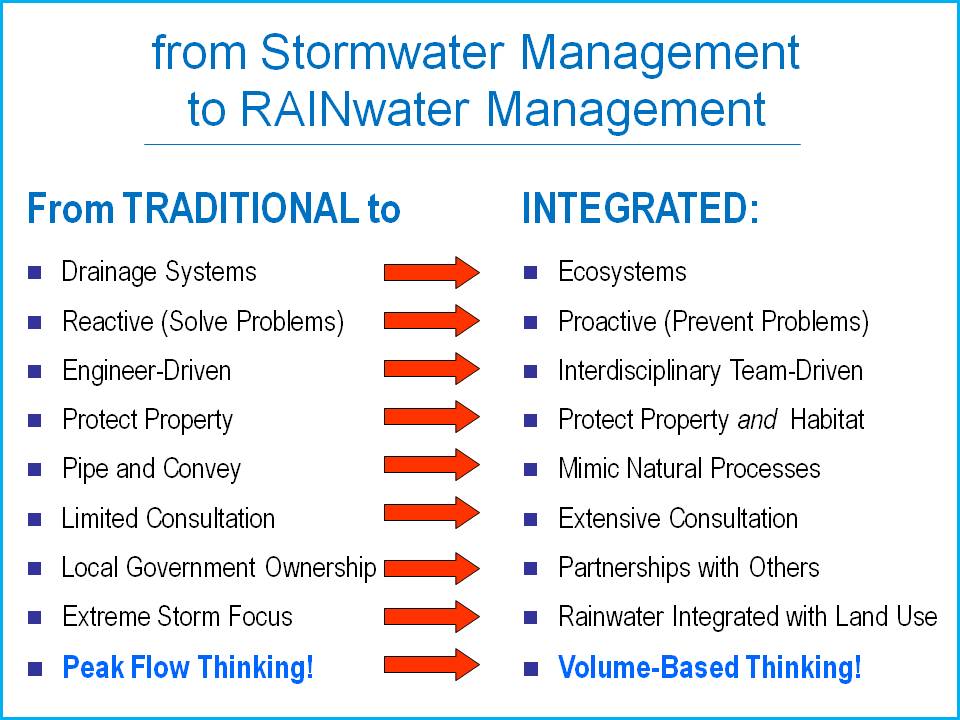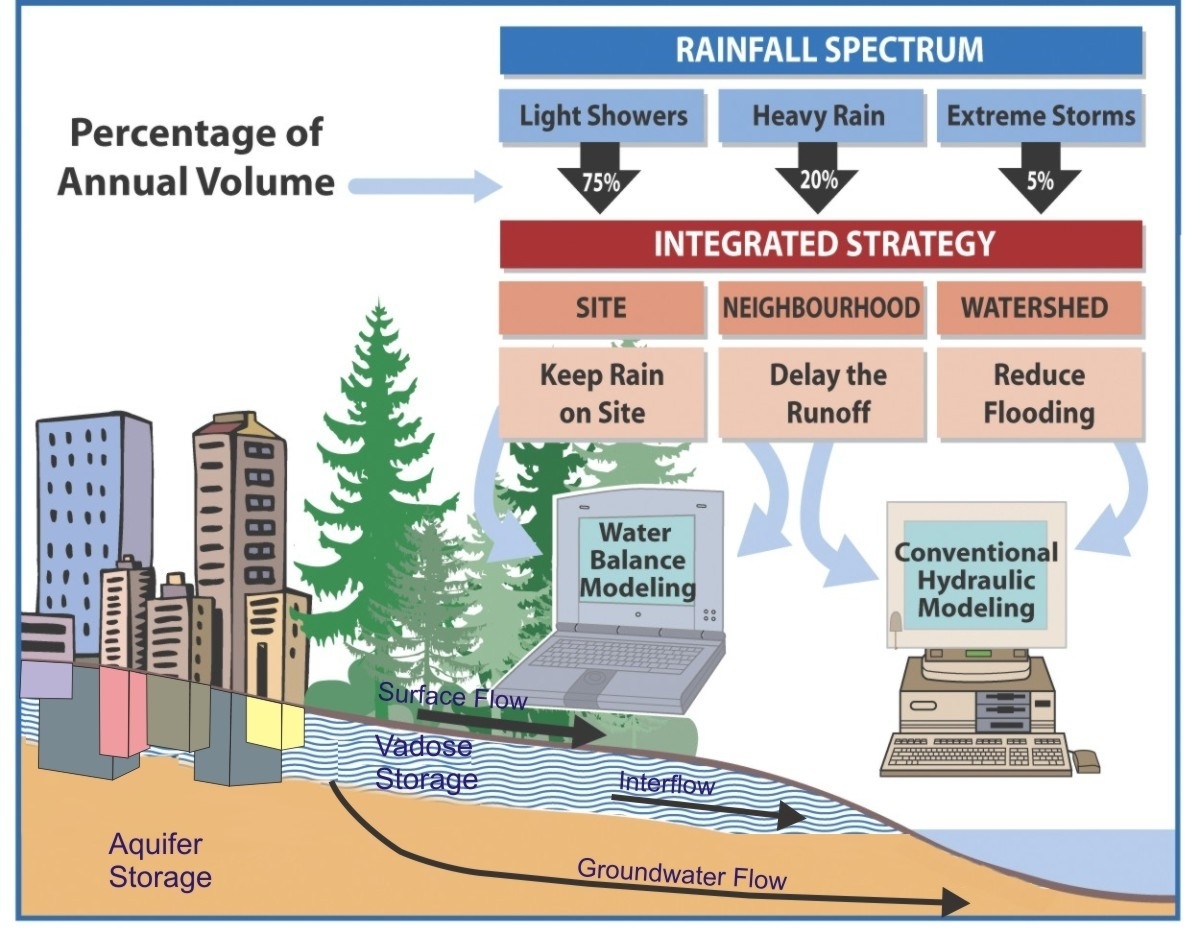FLASHBACK TO 2004: Sustainable Community Design: A New Approach to Rainwater Management (an article published by Innovation Magazine)
Note to Reader:
Circa 2004, rainwater management in North America and throughout the English-speaking world was undergoing a major sea change — and British Columbia was in the vanguard of that change.
In June 2004, Innovation Magazine published an article by Kim Stephens and Tim Pringle about the Water Balance Model for British Columbia (WBM), and how it was facilitating a paradigm shift in the philosophy of and approach to urban hydrology in British Columbia. Of note, the article commenced the branding process for a terminology shift from ‘STORMwater’ to ‘RAINwater’.
To download a copy of the article, click on Sustainable Community Design: A New Approach to Rainwater Management.

The Water Balance Model is used to evaluate the potential for developing communities that function hydrologically like naturally forested or vegetated systems. One of the many areas where the WBM is being applied is Burke Mountain, a new residential development planned for northeast Coquitlam in the Metro Vancouver region.
Rainwater management is at the heart of a new approach to land development in balance with the natural environment
“BC stormwater criteria and tools are receiving increasing recognition across North America because of their unique emphasis on solving both flooding and environmental problems at the source. This rethinking of traditional approaches to urban hydrology is helping to achieve higher levels of watershed and stream protection by integrating land use planning with volume-based analysis of stormwater management strategies,” wrote Kim Stephens in 2004
At the time he was Program Coordinator for the Water Sustainability Action Plan for BC. His responsibilities included implementation of the Water Balance Model through an inter-governmental partnership. In 2010, his role was redefined as Executive Director of the Partnership for Water Sustainability in BC.
“Before the WBM was developed, the missing link urban hydrology was a tool that could easily quantify the benefits, at a neighbourhood or watershed scale, achieved by reducing rainwater runoff volume at the site level. The WBM was developed as an extension of Stormwater Planning: A Guidebook for British Columbia.”
A Commonsense Approach
“Through the development and application of the Water Balance Model for BC, civil engineers are playing a leading role in promoting changes in the philosophy, approaches and standards that shape the urban landscape,” wrote Tim Pringle in 2004, Executive Director, Real Estate Foundation of BC. After retirement, he brought name recognition and credibility to the Partnership for Water Sustainability when he took on the challenge of Founding President.
 “Many agencies now recognize this commonsense approach to rainwater management as having triggered one of the most significant advances in urban hydrology in a generation. This was a deciding factor in the decision by the Foundation’s Board of Governors in 2003 to fund initial development of the model, and then to fund the Outreach and Continuing Education Program that supports the model.”
“Many agencies now recognize this commonsense approach to rainwater management as having triggered one of the most significant advances in urban hydrology in a generation. This was a deciding factor in the decision by the Foundation’s Board of Governors in 2003 to fund initial development of the model, and then to fund the Outreach and Continuing Education Program that supports the model.”
“The Foundation partnered with the Water Balance Model Partnership to build broad-based support for the ‘design with nature’ approach to rainwater management. Launched at the 2003 annual conference of the Union of BC Municipalities, the program comprises seminars and training workshops for a range of audiences.”
Genesis of the Shift from Stormwater to ‘RAINwater’
“The paradigm-shift from STORMwater to RAINwater began in 2004. The late Don Moore, then with Wesbild Corporation (developers of the Westwood Plateau) and later with the CIty of Coquitlam, was the catalyst for inspiring us to look at things differently,” recalls Kim Stephens.
“It was late 2003 and early 2004 when Don and I co-authored a guidance document for Wesbild about designing with nature on Burke Mountain. I remember it as though it was only yesterday when Don looked at me quizzically and asked: Why do we say stormwater management; shouldn’t it be RAINwater management?”
 “Don was a commonsense practitioner; he was not captive to terminology. Long story short, part of Don’s legacy is being the catalyst for a language-shift in British Columbia…. because that fresh perspective by Don resulted in a light-bulb moment for me and others in the inter-governmental partnership that developed the Water Balance Model for British Columbia.”
“Don was a commonsense practitioner; he was not captive to terminology. Long story short, part of Don’s legacy is being the catalyst for a language-shift in British Columbia…. because that fresh perspective by Don resulted in a light-bulb moment for me and others in the inter-governmental partnership that developed the Water Balance Model for British Columbia.”
“Not long after Don asked his thought-provoking question, Innovation Magazine invited the inter-governmental partnership to submit an article about the Water Balance Model. This led to a branding piece that we titled Sustainable Community Design: A New Approach to Rainwater Management, published in June 2004. This was a defining moment in terms of commencing the paradigm-shift in practitioner thinking that the Water Balance Model has come to symbolize.”
TO LEARN MORE:
To download a copy of the article co-authored by Kim Stephens and Tim Pringle, and published in Innovation Magazine in June 2004, click on Sustainable Community Design: A New Approach to Rainwater Management.



